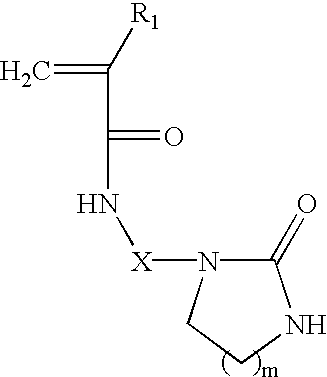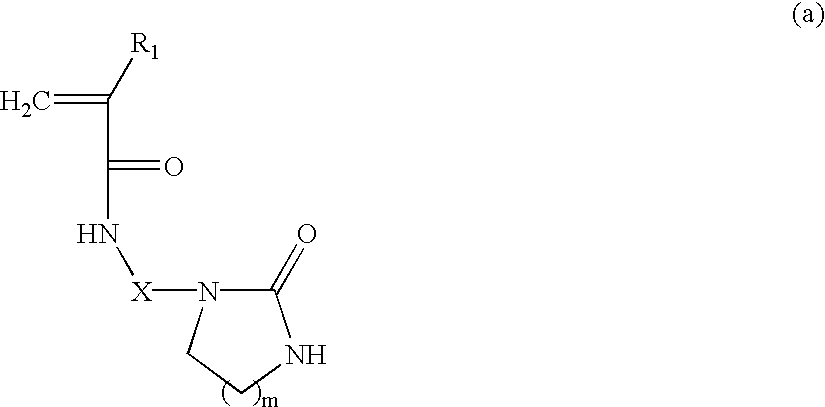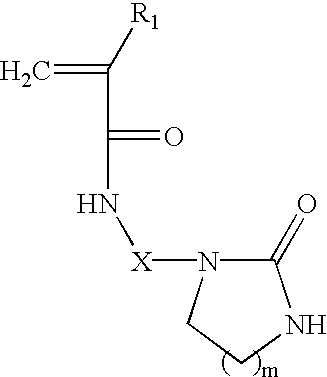Multilayer imageable elements
a technology of imageable elements and multi-layer printing, which is applied in thermography, photosensitive materials, instruments, etc., can solve the problems of time-consuming process and small change in mask dimensions, and achieve the effect of increasing the length of the press run
- Summary
- Abstract
- Description
- Claims
- Application Information
AI Technical Summary
Benefits of technology
Problems solved by technology
Method used
Image
Examples
example 1
[0100]This example illustrates preparation of a functionalized novolac resin.
[0101]N-13 (24 g, 199.75 millimoles) was added in acetone (66 g) with stirring and the resulting mixture cooled 10° C. in an ice / water bath. p-Toluene sulfonyl chloride (20.02 millimoles) at 10° C. over 1 min. Triethylamine (19.63 millimoles) was added at 10° C. over 2 min. The reaction mixture was stirred for 10 min at less than 15° C. Acetic acid (8.33 millimoles) was added at 10° C. over 10 sec, and the reaction mixture stirred for 15 min. Water / ice (160 g), and acetic acid (1.2 g, 20.02 millimoles) was added over several minutes at 15° C. and the reaction mixture stirred below 15° C. for 5 min.
[0102]The supernatant was decanted from the tacky solid that formed in the bottom of the reaction flask. Acetone (354 g) was added, and the reaction mixture stirred until a clear solution was obtained. Water / ice (160 g) and acetic acid (1.2 g, 20.02 millimoles) were added over several minutes and the reaction mixt...
example 2
[0103]This example illustrates preparation of a Copolymer 1, a copolymer having 35 mol % N-phenylmaleimide, 30 mol % methacrylic acid and 35 mol % N-[2-(2-Oxo-1-imidazolidinyl)ethyl]methacrylamide.
[0104]N-phenylmaleimide (14.58 g), methacrylic acid (1.04 g), N-[2-(2-Oxo-1-imidazolidinyl)ethyl]methacrylamide (24.39 g) (Aldrich, Milwaukee, Wis., USA, contains 30% water, 3% aminoethyl ethylene urea, 25% methacrylic acid and is inhibited with 1800 ppm HQ) and dimethyl formamide (136.01 g) were placed in a 1 L reaction kettle fitted with a reflux condenser, nitrogen supply, thermometer, stirrer, and heating mantle. Nitrogen was bubbled through the reaction mixture for one hour. The reaction was heated to 60° C. under nitrogen and 2,2-azobisisobutyronitrile (AIBN) (0.054 g in 10 g of dimethyl formamide) was added. The reaction mixture was stirred under nitrogen at 60° C. for about 20 hr. The reaction mixture was slowly added to water (about 1 L), and the resulting precipitate filtered. Th...
PUM
| Property | Measurement | Unit |
|---|---|---|
| mol % | aaaaa | aaaaa |
| wt % | aaaaa | aaaaa |
| wt % | aaaaa | aaaaa |
Abstract
Description
Claims
Application Information
 Login to View More
Login to View More - R&D
- Intellectual Property
- Life Sciences
- Materials
- Tech Scout
- Unparalleled Data Quality
- Higher Quality Content
- 60% Fewer Hallucinations
Browse by: Latest US Patents, China's latest patents, Technical Efficacy Thesaurus, Application Domain, Technology Topic, Popular Technical Reports.
© 2025 PatSnap. All rights reserved.Legal|Privacy policy|Modern Slavery Act Transparency Statement|Sitemap|About US| Contact US: help@patsnap.com



